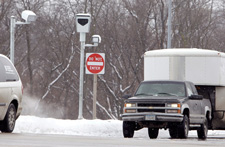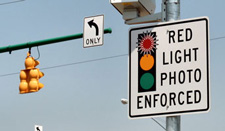Resistance builds against red-light cameras
Daily News Article — Posted on February 21, 2013
 (by Lisa Riordan Seville and Hannah Rappleye, NBC News) – …Fifteen years ago, red light cameras [were a rarity]. Now, communities in 24 states and Washington, D.C. use the cameras to try to decrease illegal — and sometimes deadly — traffic violations. Supporters say it’s worked.
(by Lisa Riordan Seville and Hannah Rappleye, NBC News) – …Fifteen years ago, red light cameras [were a rarity]. Now, communities in 24 states and Washington, D.C. use the cameras to try to decrease illegal — and sometimes deadly — traffic violations. Supporters say it’s worked.
“In the last five years we went from 54 traffic fatalities to 19,” said Cathy Lanier, police chief in Washington, D.C., which began using the cameras in 1999. “I mean, that’s dramatic!”
Red light cameras are one piece of a growing network of automated traffic enforcement. Cameras now monitor speed, bus and high-occupancy-vehicle lanes and intersections with stop signs. Proponents like Lanier say they help to deter accidents, nab violators and allow states and municipalities to keep an eye on the roads for less.
But critics of red light programs worry about the Big Brother aspect of using cameras instead of [police officers]. Many also say cameras, which are generally run by private companies, have spread not because they make streets safer, but because they mean profit for cities and companies.
“What the issue really comes down to is these companies are ripping people off by hundreds of millions of dollars, in the name of caring about our safety and our health and our kids,” said New Jersey [Republican] Assemblyman Declan O’Scanlon, who has introduced anti-red light camera legislation to the state Legislature.
 Recent news stories have fueled opposition. In Chicago, an alleged pay-to-play scandal led the mayor to ban one company from bidding for future contracts. [Pay-to-play: when an individual, business, or organization makes campaign contributions to public officials, party officials, or parties themselves, and receives benefits such as no-bid government contracts, influence over legislation, political appointments or nominations, or other favors.] Millions were spent on pro-camera lobbying in Florida and other states. In Iowa, doubts about the constitutionality of using cameras as traffic enforcers led a state senator to introduce a bill to ban red-light cameras – a move already taken by at least nine other states.
Recent news stories have fueled opposition. In Chicago, an alleged pay-to-play scandal led the mayor to ban one company from bidding for future contracts. [Pay-to-play: when an individual, business, or organization makes campaign contributions to public officials, party officials, or parties themselves, and receives benefits such as no-bid government contracts, influence over legislation, political appointments or nominations, or other favors.] Millions were spent on pro-camera lobbying in Florida and other states. In Iowa, doubts about the constitutionality of using cameras as traffic enforcers led a state senator to introduce a bill to ban red-light cameras – a move already taken by at least nine other states.
What does science say?
Red light violations were associated with some 700 deaths and nearly 90,000 injuries in 2009, according to a study based on data reported to the National Highway Traffic Safety Administration. Fatalities and injuries have decreased in recent years, the study shows.
Researchers, however, are divided on how much red light cameras increase safety.
In 2011, the Insurance Institute for Highway Safety, a nonprofit research group funded by the insurance industry, released a study that found red light cameras decreased fatal accidents by an estimated 24 percent in large cities that use them.
But a 2005 Federal Highway Administration study painted a more nuanced picture. Data from seven jurisdictions showed a decrease in front-into-side crashes at intersections with cameras. But it also showed an increase in rear-end crashes. The researchers said that apparently was the result of drivers hitting the brakes to avoid a ticket. Overall, however, the research showed the cameras saved money by both decreasing the most serious accidents, and generating revenue.
However, the FHA says that red light cameras shouldn’t be a knee-jerk traffic enforcement option. The agency issued a number of recommendations regarding the implementation of red light cameras, saying cameras should be considered only after engineering solutions have failed in problem intersections. Among the possible solutions, it says: Give drivers more cushion. Increasing yellow time by one second, it found, can result in a 40 percent decrease in crashes in stoplight-controlled intersections.
“It all hinges on proper yellow light time,” said John Bowman, communications director of the National Motorists Association, a drivers advocacy group. “If yellow lights are set properly, based on established traffic engineering, red light cameras are unnecessary because you almost automatically have low numbers of violations and low numbers of accidents. If you shorten those yellow light times beyond bare minimums, that’s when you start to generate more accidents and more violations.” …
Dollars and cents
 About 700 municipalities in the country have cameras. One of the most prominent companies, Redflex, had about 2,000 cameras in operation around the nation in 2011, bringing in over $92 million in revenue [to the company], according to its annual report. American Traffic Solutions, another big player in the industry, reports more than 3,000 road safety systems installed in the U.S. and Canada, which include red light cameras. [How much the companies put out to run the red light camera programs, or what type of contracts they have with municipalities is not mentioned in this article. For instance, how do the municipalities pay the camera companies? by allowing them a certain percentage of the money they bring in from tickets?]
About 700 municipalities in the country have cameras. One of the most prominent companies, Redflex, had about 2,000 cameras in operation around the nation in 2011, bringing in over $92 million in revenue [to the company], according to its annual report. American Traffic Solutions, another big player in the industry, reports more than 3,000 road safety systems installed in the U.S. and Canada, which include red light cameras. [How much the companies put out to run the red light camera programs, or what type of contracts they have with municipalities is not mentioned in this article. For instance, how do the municipalities pay the camera companies? by allowing them a certain percentage of the money they bring in from tickets?]
Red light cameras can also pull in big revenues for cities. An investigation by NBC 4 in Washington, D.C., found the Capitol region drivers received tickets with at least $18 million dollars in fines in one year attributable to the cameras. NBC 5 in Dallas found a single camera in Arlington, Texas, generated $2.5 million over four years.
Communities continue to adopt the technology. In 2011, East Cleveland residents votedto keep red light cameras. Last year, New Jersey’s Pohatcong Township voted to extend its contract with Arizona-based American Traffic Solutions. …
But cameras have faced increasing opposition from drivers who object to the automated systems for many reasons, including the inability to confront their accuser in court. Facing pressure from constituents, local and state politicians in Iowa, Florida, New Jersey and other states have recently introduced measures to change or end the camera programs.
Other controversies have raised questions about red light cameras. Problems with short yellow lights, which may increase the number of tickets issued, have surfaced in cities from California to Tennessee. Judges in Baltimore have castigated the city and thrown out tickets after finding the city had shortened yellow lights below recommended limits. Last summer, the New Jersey Transportation Department ordered 21 red light programs suspended after finding yellow-light timing issues. Meanwhile, camera companies have sued, or threatened to sue, cities who back out of contracts. And they’ve been investigated for possible pay-to-play schemes with local governments.
“They’re very aggressive in terms of lobbying for favorable legislation or favorable court cases,” said Bowman of the National Motorists Association. “It’s big business, and there’s a lot of money at stake.”
Last October, Chicago Mayor Rahm Emanuel barred Redflex from re-bidding on the city’s red-light camera contract after a Chicago Tribune investigation found that Redflex company executives and lobbyists had paid for hotel rooms and spent thousands on entertainment for the city official overseeing the red light program.
Chicago’s red light cameras raised big revenues for the city. Redflex has operated a red-light program in the city since 2003, generating about $300 million in fines for the city and $97 million in revenue for itself. Residents in the city have long complained about discrepancies between yellow light times in the city and its suburbs. …
Automated traffic enforcement companies like [Redflex and American Traffic Solutions] spend millions persuading local and state lawmakers to expand programs, using lobbyists, municipal partners and nonprofits to advance the cause. After spending $1.5 million lobbying Florida lawmakers over four years, American Traffic Solutions became the main-red light camera supplier in the state, winning contracts in more than 65 cities.
Territo, the spokesperson for American Traffic Solutions, defended efforts to expand red light camera programs, which he emphasized are above all about safety. “Just as opponents of red-light safety cameras fund efforts to remove cameras, we expend resources on efforts to defend them,” he said.
Recognizing growing opposition to red light enforcement technologies, companies are looking to new markets. Both Redflex and American Traffic Solutions have active speed cameras in various markets, though 12 states have banned the technology. Both companies have also started programs to enforce rules prohibiting drivers from going around stopped school buses.
Redflex recently became the nation’s largest provider of school bus arm cameras, which catch drivers who speed past the stop signs that swing out from the side of school buses. The company has launched 10 pilot programs in six states.
Reprinted here for educational purposes only. May not be reproduced on other websites without permission from NBC News. Visit the website at openchannel.nbcnews.com.
Background
Problematic cameras
A yellow light in Cary, N.C., had Howard Bond seeing red.
Last year Bond’s son was issued two different tickets for turning left on a red light at an intersection. But when Bond watched videotape of the alleged traffic offenses, he saw that in both instances his son had legally turned left on a flashing yellow light. The town had recently switched to a flashing yellow at the intersection, but Redflex, the private company running the cameras, kept treating it as a red, Bond said.
Each time, Bond, who lives in nearby Chatham County, went to the office that issued the tickets to complain. Each time, he said, his tickets were dismissed but the larger issue was ignored.
"I just basically stood there and said, ‘No sir, you’re going to look at the video,’” Bond told NBC News. But law enforcement officials told him he would have to attend a hearing to contest it.
"I said 'We’re not going through all that,'” Bond said. “He started hee-hawing around. Then he looked at the video and said, ‘This is wrong.’"
After a local television news station approached town officials with Bond’s tickets, details emerged about tens of other tickets wrongfully issued in Cary by faulty red light cameras last year. A review of its red light cameras found that cameras in one intersection had generated at least 31 false violations, many of which led to $50 tickets.
Town officials told the Raleigh News and Observer that Redflex had failed to report the error to the town.
But Jody Ryan, spokesperson for Redflex, said the company took action as soon as it discovered the wrongful tickets.
“In this situation, changes were made by the Town of Cary to the traffic light phases without Redflex Traffic Systems, Inc. knowledge,” Ryan said. “Because we were unaware of these changes, our systems triggered a set of false positives. Once we were notified of the issue Redflex either dismissed or refunded all the affected citations on behalf of the Town of Cary.”
While major cities can make millions off red light cameras, in some contracts red light camera companies keep the majority of funds paid by violators. Redflex’s contract with Cary, for instance, allowed the company to keep 88 percent of the money generated by red-light camera tickets in Cary. Between April 2004 and July 2012, ticketed drivers paid $5.7 million to the company, and $646,000 to the Wake County Public School System, which received the city’s proceeds.
The controversy led town officials to abandon its red-light camera program altogether.
Cary is one of a number of communities, including large cities such as Houston, that have recently abandoned their camera programs amid opposition from residents. (from the NBC News report)
